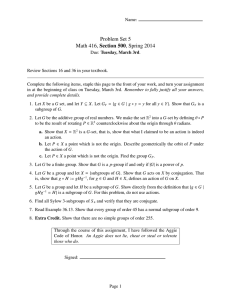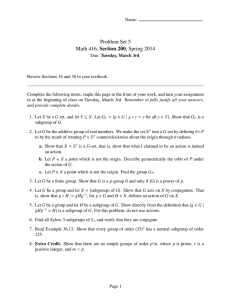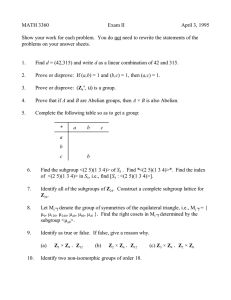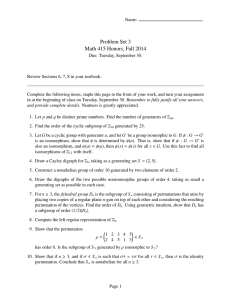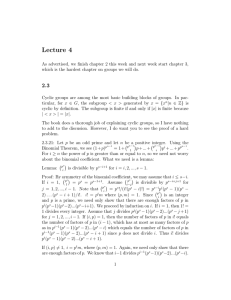Document 10438071
advertisement
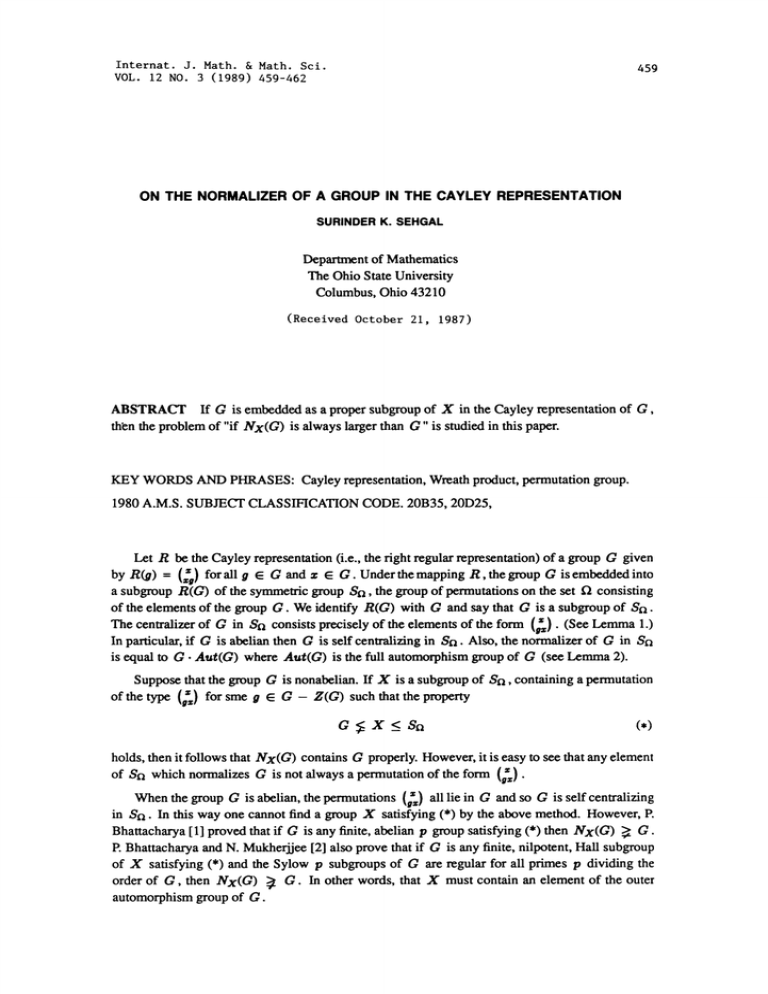
Internat. J. Math. & Math. Sci.
VOL. 12 NO. 3 (1989) 459-462
459
ON THE NORMALIZER OF A GROUP IN THE CAYLEY REPRESENTATION
SURINDER K. SEHGAL
Department of Mathematics
The Ohio State University
Columbus, Ohio 43210
(Received October 21, 1987)
ABSTRACT If G is embedded as a proper subgroup of X in the Cayley representation of G,
then the problem of "if Nx(G) is always larger than G" is studied in this paper.
KEY WORDS AND PHRASES: Cayley representation, Wreath product, permutation group.
1980 A.M.S. SUBJECT CLASSIFICATION CODE. 20B35, 20D25,
Let R be the Cayley representation (i.e., the right regular representation) of a group G given
forall g E 17 and a: E 17. Under the mapping R,thegroup 17 is embedded into
by Rill)
a subgroup R(17) of the symmetric group Sta, the group of permutations on the set fl consisting
of the elements of the group 17. We identify R(17) with 17 and say that 17 is a subgroup of
The centralizer of 17 in Sn consists precisely of the elements of the form (gz). (See Lemma 1.)
In particular, if 17 is abelian then 17 is self centralizing in Sn. Also, the normalizer of 17 in Sn
is equal to 17- Aut(17) where Aut(17) is the full automorphism group of 17 (see Lemma 2).
(z)
Suppose that the group 17 is nonabelian. If X is a subgroup of Sn, containing a permutation
(gf if i) for sme g E G Z(G) such that the property
of the type
G
; x _< Sn
(,)
holds, then it follows that Nx(G) contains G properly. However, it is easy to see that any element
of Sn which normalizes (7 is not always a permutation of the form
(a).
{z)
all lie in 17 and so 17 is self centralizing
When the group 17 is abelian, the permutations
satisfying (*) by the above method. However, P.
17.
Bhattacharya 1] proved that if 17 is any finite, abelian p group satisfying (*) then Nx(17)
P. Bhattacharya and N. Mukherjjee [2] also prove that if 17 is any finite, nilpotent, Hail subgroup
of X satisfying (*) and the Sylow p subgroups of 17 are regular for all primes p dividing the
17. In other words, that X must contain an element of the outer
order of 17, then Nx(17)
automorphism group of 17.
in
Sn. In this way one cannot find a group X
>
460
S.K. SEHGAL
In this paper we will igrove that if 17 is any abelian Hall subgroup of X, satisfying the condition
(*) then 17
Nx(17). We will also give an example to show that the condition of being Hall
subgroup is necessary in the above theorem. We will also show that if 17 is any nilpotent, Hall
subgroup of X satisfying the condition (*) and the Sylow p subgroups P of 17 do not have a
factor group that is isomorphic to the Wreath product of g, gp then 17
Nx(17). In particular
it follows that if 17 is any finite p-group and does not have a factor group isormophic to 2’,
then 17
Nx(G) [i.e., the condition being a Hall subgroup is not necessary]. As a corollary it
also follows that if 17 is any regular p-group satisfying the conition (*) then G
Nx(G). We
will give an example to show that the condition of 17 having no factor group isomorphic to 2’,
is necessary.
:
:
<
Lemma 1. Let R be the fight regular representation of a finite group 17 and L, the left regular
representation of 17. Under the mappings L and R, the groups L(G) and R(17) are subgroups
of S and Csa(R(G)) L(G).
(,}
Let
Proof:
e R(G),
xg
Hence L(G)
{h:} e L(G)
hx
xg
xg
hxg
hx
hxg
hx
xg
C8a(R(G)).
C_
Now suppose
1)
Since
Hence
Hence
Lem
Pf:
t
(zg)’
z’g’
Hence Aut(G) C. Nsa(R(G)). Conversely, let (ffi,} be an arbitrary element of Nsa(G). Let
1’ So (ffin-l} E R(G). Let 0 (ffiffi,)(ffi,-r}. So 0 sends to 1. Now {ffiffi0} -1 {ffi)(ffi) E
x, O. g*.
since it lies in R(G), i.e., (x.g) 0
R(G). So
(ffig)((ffi;o)
go (xg)o xo.gO =, 0 is an autormophism of G
Plug in x
1,weget g*
Nsa(R(G)) R(G). Aut(G).
a
(ffi:}
Lemma 3:
((figS0)
=
(;o}
Let 17 be any finite group satisfying the condition (*). Then for any
(i)
G
(ii)
X=
(iii)
Xa
Cl
Xa
=
t
f
{e}.
a.x,
is corn free, i.e., it does not contain any non-identify normal subgroup of X.
Proof: Recall that here G is identified with R(G) in G <_ X <_ Sty. Since R is the fight
regular representation of G, so R(g) does not fix any a t’l except when g e. So G CI Xa
461
NORMALIZER OF A GROUP IN THE CAYLEY REPRESENTATION
c
Also X acts transitively on fl, [wx" I=1
I=1 el. Now [X.X.] =1 i=1 el.
So X dr. Xa. For part (iii)suppose N X and N C_ X,. So N C t"lexz-lXaz, i.e.,
if n is an arbitrary element of N, then n can be written as n
z-luz for all a: E X and
tx since u fixes
u-z or tx
some u E Xa. Here u depends on z, i.e., z-n
a’
X, but X acts transitively on fl
a, i.e., n fixes t for all z
n fixes every element of
N {e}.
X
n e
{e}.
=
=
=
Lemma4: (Core Theorem): Let H beany subgroupof dr with [dr" H] n. then dr/eoreH
is isomorphic to a subgroup of ,.q, where core H is the largest normal subgroup of dr which is
contained in H.
Let fl be the set of distinct right cosets of H in dr, i.e.,
Hgn} Then the mapping a defined by a(.q)
Proof:
{Hgl Hg2,
permutation representation of dr of degree n with Kernel of
tr
Hg,
\ Hgig
is a transitive
core H.
Theorem 5: Let dr be a finite abelian, Hall subgroup of X, satisfying the condition (*). Then
Nx(dr) dr.
>,
Proof: Suppose the result is false, i.e., there exists a subgroup X of S satisfying dr
X _<
S and Nx(dr) dr. Amongst all subgroups of Sn containing dr property, pick X to be
2
smallest. In other words, dr is a maximal subgroup of X Let Idrl
,P2 "’,P* with p
distinct primes. Let Pi be Sylow pi subgroups of dr for i
1,2,... ,t. Since dr is a maximal
X. Renumber the pi’s if necessasry and say
subgroup of X, so Nx(Pi)
dr or Nx(Pi)
dr for i
X for i t+l,...,t. For i
Nx(Pi)
l,...,t and Nx(Pi)
l,...,l,
dr. So by Burnside Lemma X has a normal Pi complement. For 3"
C,x(Pi)
Nx(Pi)
l + I,...
Pj ,a X =. Cx(Pj) ,a X dr C_. C,x(Pj)
Cx(PI) X Nx(P). So X has
P’
,,
=
a normal P/ complement
Mi for all i
= Xa
Lemma 3.
1 Mi, Xa
S which is a contradiction to
i=I
In the case where dr is abelian, but not Hall subgroup of X, the result is not true as illustrated
by the following example.
-
Z3 x $3 (a) x (b, clb3 c2 1, c-lbc b-).
Z2 (a) (c) Z6. Let H be the subgroup of X of order 3 generated
Example6: Let X
Let G Z3
by the ordered pair (a, b). Then H is not normal in X since (e, e) does not normalize H. So
H is core free, of index 6 in X. By Lemma 4, dr
X < $6. Now dr is abelian, not Hall
subgroup of X and Nx(dr) dr.
Let dr be a finite, nilpotent, Hall subgroup of X, satisfying the condition (*).
Theorem 7:
Suppose that the Sylow p subgroups P of dr do not have a factor group isomorphic to the Wreath
product of Z, Zp for all primes p dividing the order of dr. Then Nx(dr)
dr.
Proof: Suppose the result is false, i.e., there exists a subgroup X of Sa satisfying dr
X<
St and Nx(dr) dr. Amongst all subgroups of Sfa containing dr properly, pick X to be
smallest. In other words dr is a maximal subgroup of X. Let dr [= 1o’ "P2ix2
P’, here
P x P2 x x Pt where Pi are Sylow
Pi are all distinct primes. Since dr is nilpotent, so dr
X. Renumber the Pi’s if
dr or Nx(Pi)
Pi subgroups of dr. So we have either Nx(Pi)
necessary and say Nx(Pi) dr for i 1, ...l and Nx(Pi) X for i l + 1,... ,t.
Let us look at the case i
1,..., l. We have N
theorme [3], X has normal Pi complement Mi.
Let M
So
P,X
PjCX(Pj)
I’li/=l M
So 10i
’IMI for i
which implies that
X.
Nx(Pi)
dr. By Yoshida’s transfer
1,...,l. Now for j t+ 1,...,t, Nx(Pj) X.
Ux(Pj)’ X and PUx(P)’ X and dr C_ Pj. Ux(P)
=
462
S.K. SEHGAL
I; ([ G [,[ X= D
G.X=; G X=
x
-"+
t+
t. M l= v+,
...v’ IX,
XuAG, which is a concfion to
Xu is a chactedsfic sub.up of MAG
For x fl, byLemma3 X
X. c CM(Pj)
Cx(Pj) n M
X=
for j
As an immediate corollary to the theorem, we get the result of P. Bhattacharya and N. Mukhcrjee [2].
Corollary $:
Let G be a finite, regular 10 subgroup of X and satisfies the condition (*), then
Proof: If G is not a Hall subgroup of X then G is propertly contained in a Sylow p subgroup
So we can assume that G is a Hall subgroup of X. Now G being a
of X and so Nx(G) >4regular p group
G does not have a factor group isomorphic to p g,. So Theorem 7 proves
the result.
=
"
Let G be a finite, nilpotent, Hall subgroup of X, satisfying the condition (*).
Suppose further that Sylow p subgroups of G are regular for all primes p dividing the order of
G then Nx(G) G.
Corollary 10: Let G be a finite p group, satisfying the condition (*). Suppose that G does not
have a factor group isomorphic to Zp Z,, then G
Nx(G).
The condition that the Sylow p subgroups of G in Theorem 6 have the property that it has no
homornorphic isomorphic to Zn Zp is necessary. Se example below.
Corollary 9.
>+
__
Example: Let X be the simple group of order 168. Let G E Sld2(X). Then G
Z2 Z2
so G is nilpotent, Hall subgroup of X. Since H
the normalizer of a Sylow 7 subgroup has
index 8, so by Lemma 4, G
X ,.qs, i.e., G satisfies the condition (*) but Nx(G) G.
"
References
1.
2.
3.
4.
:5.
6.
P. Bhattacharya, On the normalizer of a group in the Cayley representation, Bull. Austrian
Math. Soc. 2:5 (1982) 81-84.
P. Bhattacharya and N. Mukherjee, On the normalizer of a subgroup of a finite group and
the Cayley embedding; J. of Pure and Applied Algebra 33 (1984) 253-257.
T. Yoshida, Character theoretic transfer; J. of Algebra :52, (1978) 1-38.
B. Huppert, Endliche Gruppen (Springer, New York, 1967).
M. ISSACS, Character Theory of Finite Groups. (Academic Press 1976).
H. Zassenhaus, The Theory of Groups (Chelsea, 19:56).
